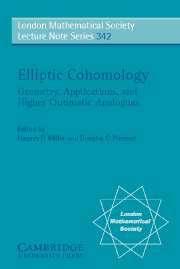Book contents
- Frontmatter
- Contents
- Preface
- Charles Thomas, 1938–2005
- 1 Discrete torsion for the supersingular orbifold sigma genus
- 2 Quaternionic elliptic objects and K3-cohomology
- 3 The M-theory 3-form and E8 gauge theory
- 4 Algebraic groups and equivariant cohomology theories
- 5 Delocalised equivariant elliptic cohomology (with an introduction by Matthew Ando and Haynes Miller)
- 6 On finite resolutions of K(n)-local spheres
- 7 Chromatic phenomena in the algebra of BP*BP-comodules
- 8 Numerical polynomials and endomorphisms of formal group laws
- 9 Thom prospectra for loopgroup representations
- 10 Rational vertex operator algebras
- 11 A possible hierarchy of Morava K-theories
- 12 The motivic Thom isomorphism
- 13 Toward higher chromatic analogs of elliptic cohomology
- 14 What is an elliptic object?
- 15 Spin cobordism, contact structure and the cohomology of p-groups
- 16 Brave New Algebraic Geometry and global derived moduli spaces of ring spectra
- 17 The elliptic genus of a singular variety
2 - Quaternionic elliptic objects and K3-cohomology
Published online by Cambridge University Press: 03 May 2010
- Frontmatter
- Contents
- Preface
- Charles Thomas, 1938–2005
- 1 Discrete torsion for the supersingular orbifold sigma genus
- 2 Quaternionic elliptic objects and K3-cohomology
- 3 The M-theory 3-form and E8 gauge theory
- 4 Algebraic groups and equivariant cohomology theories
- 5 Delocalised equivariant elliptic cohomology (with an introduction by Matthew Ando and Haynes Miller)
- 6 On finite resolutions of K(n)-local spheres
- 7 Chromatic phenomena in the algebra of BP*BP-comodules
- 8 Numerical polynomials and endomorphisms of formal group laws
- 9 Thom prospectra for loopgroup representations
- 10 Rational vertex operator algebras
- 11 A possible hierarchy of Morava K-theories
- 12 The motivic Thom isomorphism
- 13 Toward higher chromatic analogs of elliptic cohomology
- 14 What is an elliptic object?
- 15 Spin cobordism, contact structure and the cohomology of p-groups
- 16 Brave New Algebraic Geometry and global derived moduli spaces of ring spectra
- 17 The elliptic genus of a singular variety
Summary
Abstract. We shall outline a research program which aims to provide a geometric approach to K3-cohomology. We define for this a quaternionic analogue of Segal's elliptic objects.
INTRODUCTION
The relation between one dimensional formal group laws and complex oriented generalised cohomology theories, which is a consequence of Quillen's theorem which relates Lazard's ring – the ring over which is defined the universal formal group law – and the coefficient ring of complex cobordism, has been a very fruitful source of research in algebraic topology. Among one dimensional formal group laws three have a direct geometric interpretation. They are obtained from the additive group, the multiplicative group and elliptic curves respectively by taking completion at the origin. The corresponding cohomology theories, Ordinary cohomology, K-theory and Elliptic cohomology also have geometric interpretations. These interpretations have extended their use, and helped to find applications of them, to other fields of mathematics and physics besides algebraic topology.
No other one dimensional commutative formal group law is associated to a group in this direct way. However M. Artin and B. Mazur showed that one can associate formal groups to certain algebraic varieties – among them K3 surfaces – in a way which generalises the case of elliptic curves. M. Hopkins used their work to define an associated generalised cohomology theory: K3-cohomology. The geometric origin of the formal group laws associated to K3 surfaces gives a reason to hope that there exists a geometric definition of K3 cohomology.
Information
- Type
- Chapter
- Information
- Elliptic CohomologyGeometry, Applications, and Higher Chromatic Analogues, pp. 26 - 43Publisher: Cambridge University PressPrint publication year: 2007
